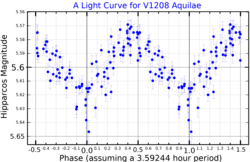28 Aquilae
Star in the constellation Aquila From Wikipedia, the free encyclopedia
28 Aquilae, abbreviated 28 Aql, is a star in the equatorial constellation of Aquila. 28 Aquilae is its Flamsteed designation though it also bears the Bayer designation A Aquilae, and the variable star designation V1208 Aquilae. It has an apparent visual magnitude is 5.5,[4] making this a faint star that requires dark suburban skies to view (according to the Bortle Dark-Sky Scale). The annual parallax shift of 9.6 mas means this star is located at a distance of approximately 340 light-years (100 parsecs) from Earth.
| Observation data Epoch J2000 Equinox J2000 | |
|---|---|
| Constellation | Aquila |
| Right ascension | 19h 19m 39.34802s[2] |
| Declination | +12° 22′ 28.8457″[2] |
| Apparent magnitude (V) | 5.51 - 5.56[3] |
| Characteristics | |
| Spectral type | F0 III[4] |
| U−B color index | +0.182[5] |
| B−V color index | +0.257[5] |
| Variable type | δ Sct[3] |
| Astrometry | |
| Radial velocity (Rv) | +4.36[4] km/s |
| Proper motion (μ) | RA: +4.249[2] mas/yr Dec.: +16.199[2] mas/yr |
| Parallax (π) | 9.5836±0.0768 mas[2] |
| Distance | 340 ± 3 ly (104.3 ± 0.8 pc) |
| Absolute magnitude (MV) | +0.46[6] |
| Details | |
| Mass | 2.4[2] M☉ |
| Radius | 4.8[2] R☉ |
| Luminosity | 54.20[6] L☉ |
| Surface gravity (log g) | 3.41[7] cgs |
| Temperature | 7,250[4] K |
| Metallicity [Fe/H] | −0.16[4] dex |
| Rotational velocity (v sin i) | 57[8] km/s |
| Age | 655[2] Myr |
| Other designations | |
| 28 Aql, V1208 Aql, BD+12°3879, HD 181333, HIP 94982, HR 7331, SAO 104722[9] | |
| Database references | |
| SIMBAD | data |
The spectrum of this star matches a stellar classification of F0 III.[4] Despite consistent spectral classifications as a giant star,[10] models show that it is just reaching the end of its main sequence lifetime at an age of 655 million years.[2]
The variability of 28 Aquilae was discovered by Michel Breger in 1969. It was revealed to be a Delta Scuti-type pulsating variable star with at least two periods of pulsation. The known periods have frequencies of 6.68 and 7.12 cycles per day.[11] The outer atmosphere has an effective temperature of 7,250 K,[4] which lies in the range of a yellow-white hued F-type star.[12]
References
External links
Wikiwand - on
Seamless Wikipedia browsing. On steroids.

